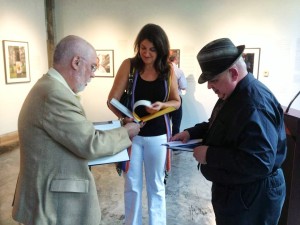
This past Thursday evening, September 12, I met fellow TKZ blogger Joe Moore for the first time at a reading and signing in Baton Rouge. The event was held at the Shaw Center for the Arts, a beautiful facility a block away from the Mississippi River. The event was a gallery exhibit for a new short fiction collection entitled Show & Tell. Photographer William Greiner commissioned short stories from twenty-eight authors, including Joe and myself (and Julie Compton, the rose between the two thorns pictured above) (photograph by Andre Chapoy; all rights reserved) by sending each author a different set of three photographs and asking each of us to write a story based upon one of them. The photographs and accompanying stories now constitute a traveling exhibit, and also have been published in hardcover. Joe, Julie, Pat Piper, and I read our stories as part of the exhibit’s opening reception and then signed copies of the book afterward. Show & Tell in hardcover book form is available for purchase at: http://www.ulpress.org/catalog.php?item=142
A wonderful time was had by all. I decided after participating that it might be time to review (for those of us fortunate enough to be in the position that Joe M. and I were in the Thursday last) what we as authors need to do to make such an event a success. Let me hasten to tell you that I simply followed Joe M.’s lead: he is as genuinely a courteous a person as you are ever likely to encounter.
1) Show up on time. Woody Allen has famously stated that ninety percent of everything is showing up. How true. If you’re early, you’re on time; if you’re on time, you’re late; and if you’re late, you’re too late. You don’t want to disappoint people who are coming to see you. How fortunate we are, that we can do something that people will actually come to bear witness to. The least we can do is show our appreciation by appearing early.
2) Stay later. If the program/signing/reading has an end time, plan to stay at least five minutes later than that. You can visit with people who came to see you, or, if nothing else, engage in Number 5, below.
3) Be expressive. If you’re doing a reading, practice it a few times before the time appointed. Be expressive. Change your tone of voice and your facial expression while you read to reflect what is going on at the point in your story that you are reading. Reading by rote in a monotone can ruin even the best passage. An expressive reading, by contrast, can make good work better. Harlan Ellison is terrific at this, by the way. He can hold a room full of fans spellbound, making them roar with laughter at one point and silencing them the next. Which brings me to
4) Adapt. Nothing goes as planned. Jack Rea…er, Helmuth von Moltke famously said that “No battle plan survives contact with the enemy.” Just so. There were significant problems with the microphones at Show & Tell; a portion of the audience, well-lubricated by the top shelf libations which William provided, was a bit loud during the readings. What to do? Keep reading, with a smile. Some people were actually listening, and those are the folks you are reading for. Things will go wrong. Plan on it. Go around, over, under, or through the difficulty and do whatever you need to do. It’ll work out.
5) Thank everyone individually. You cannot thank too many people. Thank your friends who attended (O’Neil & Debb De Noux; Carl & Toni McGee Causey; Doug Wollfolk; Jason Furrate; and Andre Chapoy: thank you again, one and all); each person who buys a book; each person who asks you to sign a book; and the folks that got you there and propped you up (thank you again, William, and you as well, John Miller). I particularly include in the latter group the seemingly invisible people who restock the refreshments and run the cash registers. I thanked one of them last night and she told me that I was the first person attending any of the center’s events who had thanked her for being there. That’s plain wrong. It only takes a second. They’ll remember you, particularly if you’re ever asked back.
I am sure that there are things I have forgotten. John Gilstrap has hilarious stories about things going wrong at signings (his visual accompaniments are priceless) so John, if you’re lurking out there please chime in, and I would ask each and all of you to do the same. And if you’ve attended a signing or a reading as an audience member what happened that you liked? Or that you didn’t?

